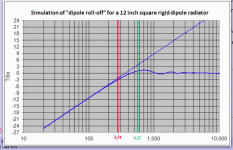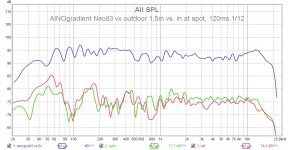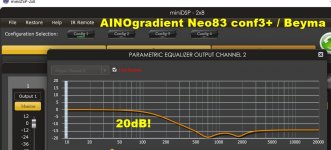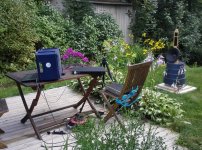Nice HD%, clocking in around -40 dB (1%). Pretty good for cones (ESL come in around -50 dB).
But you might already be bumping against the lower limits of your measuring system and the real figures are even lower.
B.
I might have been running out of headroom on the amp running the woofer channel. It's only 60WPC into that load and I have a +6dB boost on the lower end of the response. I think it's not all that bad even as it stands.
Anyway, no worries about the "dust up".
I think it's not all that bad even as it stands.
Don't forget to turn off the A/C and furnace fan. DAMHIK.
B.
Looking nice progress and yes, prototyping and measuring/listening is the most fun part!
Some comments
- indoor measuring is ok when one learns to identify the specific issues (reflections) in response. These happen mostly at f below 400Hz when speaker is in the middle of the room
- backside reflections in listening setup happen at higher f, because walls are closer
- off-axis behaviour of the double tweeter shows low directivity (dipole action lost) around 4kHz, but modestly because of waveguide effect is masking it.
- high distortion around 100Hz is mostl likely stressing of the woofer and the amp, both!
- 90dB/1m only just starts to show midrange and tweeter distortion, 95dB is better, but 100dB/1m must be tested too! NRC publishes big speakers' distortion 95dB/2m.
Some comments
- indoor measuring is ok when one learns to identify the specific issues (reflections) in response. These happen mostly at f below 400Hz when speaker is in the middle of the room
- backside reflections in listening setup happen at higher f, because walls are closer
- off-axis behaviour of the double tweeter shows low directivity (dipole action lost) around 4kHz, but modestly because of waveguide effect is masking it.
- high distortion around 100Hz is mostl likely stressing of the woofer and the amp, both!
- 90dB/1m only just starts to show midrange and tweeter distortion, 95dB is better, but 100dB/1m must be tested too! NRC publishes big speakers' distortion 95dB/2m.
C-weighted is flat, not that much precision is really needed.....I have an SPL meter, so I did an A-weighted reading at the mic...
B.
C-weighted is not flat, it is around 10dB down at the frequency extremes. Z-weighting is flat.
Z-weight isn't flat either. Flat is called "flat". Numerous reasons not to obsess about z-weight. Please see my signature aphorism.
1. Not sure any of us own (or could afford to buy) meters with authentic z-weighting (first defined about 15 yrs ago)
2. fussing about whether a modestly priced SPL meter is reading right at 10 Hz or 20 kHz and fussing about what my speakers and room are doing at those extreme extremes is a not productive.
3. going through the motions of "calibration" of REW with an SPL meter is analogous to what Mark Twain said about "baptism"
"Mark Twain was once asked whether he believed in infant baptism; he responded, "Believe in it? I’ve seen it done!""
B.
Last edited:
Thanks, yes its fun when it finally comes to fruition!Looking nice progress and yes, prototyping and measuring/listening is the most fun part!
Some comments on your comments...
Yes, that's true but I am not sure about what you are trying to say about reflections. I do not try to compensate the loudspeaker for the room. What you see with a microphone, e.g. a null from a reflection off a specific wall (e.g. rear wall) is not necessarily a good representation of what you will hear from the loudspeaker because a microphone is not the same as ears+brain=hearing. The rear wall reflection will be folded in with other "early arrivals" by the brain and, as I understand it, as long as you keep the tonal balance of the reflected sound as similar as the first arrival (direct sound) the brain just adds it to the total perceived loudness. If the tonal balance of the reflection is not the same it will influence the perceived timbre. For this reason, a dipole in a relatively live (but not echo-y) room can sound very good, probably better than in a relatively damped room. As evidence for this, I previously prototyped a system in a practically bare room with a hard wood floor and it sounded very "spatious", IMO due to the boundary reflections adding to the overall soundfield perceived by the brain via input from the ears over time.Some comments
- indoor measuring is ok when one learns to identify the specific issues (reflections) in response. These happen mostly at f below 400Hz when speaker is in the middle of the room
- backside reflections in listening setup happen at higher f, because walls are closer
Hmmm, not sure I follow. For example in this plot I do not see what you are talking about. Looks all dipole to me:- off-axis behaviour of the double tweeter shows low directivity (dipole action lost) around 4kHz, but modestly because of waveguide effect is masking it.
Maybe you were thinking about a different plot or plot feature when forming that opinion? Please let me know.
- high distortion around 100Hz is mostl likely stressing of the woofer and the amp, both!
- 90dB/1m only just starts to show midrange and tweeter distortion, 95dB is better, but 100dB/1m must be tested too! NRC publishes big speakers' distortion 95dB/2m.
If I want to do higher SPL distortion testing I will need to move from the onboard sound to an outboard unit with higher output voltage capability. The onboard one can barely do 1Vrms... and the distortion performance of the codec is not stellar, although still well below the loudspeaker itself. It was more for the convenience of it. It's probably best saved for a later stage and not the prototype.
Sorry I was a bit in a hurry - it was an exceptionally warm sunday morning here and my oldest daughter just arrived for a summer visit back home from London...
I was lookig at this (backwards) table
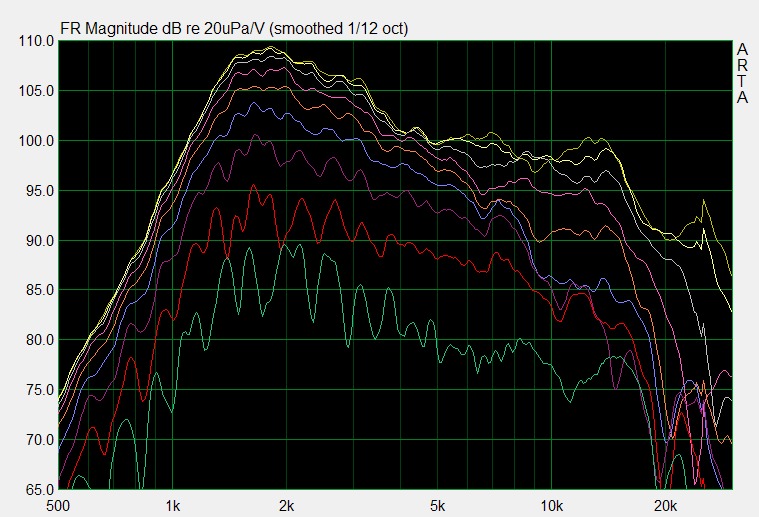
Frontside responses were smoother, but shouldn't they be similar? Anyway this is very good! It is an academic question if you want to make radiation/off-axis responses any more symmetrical and by-the book dipole. I fell in that cave...
About room reflections, they are always there yes, despite of how a measurement mic captures them. I am not worried about them like bentoronto, I just wanted to emphasize that the diyer should learn to recognize them in measurements.
I was lookig at this (backwards) table
Frontside responses were smoother, but shouldn't they be similar? Anyway this is very good! It is an academic question if you want to make radiation/off-axis responses any more symmetrical and by-the book dipole. I fell in that cave...
About room reflections, they are always there yes, despite of how a measurement mic captures them. I am not worried about them like bentoronto, I just wanted to emphasize that the diyer should learn to recognize them in measurements.
Last edited:
Can you post a scan of these textbook illustrations please... dipole rear waves sneaking around and annihilating the front wave - at least in textbook illustrations
Z-weight isn't flat either. Flat is called "flat".
To remove any further confusion readers may want to look towards the IEC61672:2014 standard for clarification. There are tables for weighting factors in that document that are reproduced here:
Frequency-Weightings for Sound Level Measurements.
Folks, this thread is not about which weighting method is more accurate or flat or whatever. Please take that discussion into a new thread.
I only reason I used A-weighting was because I had an SPL meter that could measure SPL under that condition and I need some kind of independent SPL measurement. It was a fallback when the rest of the signal chain could not be calibrated, and the meter was a way to adjust the SPL level to match the SPL shown in my measurement software.
I only reason I used A-weighting was because I had an SPL meter that could measure SPL under that condition and I need some kind of independent SPL measurement. It was a fallback when the rest of the signal chain could not be calibrated, and the meter was a way to adjust the SPL level to match the SPL shown in my measurement software.
Can you post a scan of these textbook illustrations please
Since Bolserst posted it (post #5), nobody would dispute it:
Dipole phase-cancellation in ESL speakers
Turn the diagram upside-down and it should look like a Linkwitz Transform.
That's the theory - the one I sometimes call "wave arithmetic". Now I'd like to see how a dipole works in a real room. There are all kinds of ways to explore this question. Maybe the best test is simply out of doors (where the wave arithmetic ought to hold precisely) versus indoors.
B.
Attachments
Last edited:
Basics to Ben et al.
Dipole cancellation causes 6dB/ot roll-off in spl blelow certain frequency that is determined by baffle width. This roll-off must be compensated of course, typically by attenuating higher frequencies respectedly. (boosting lows will lead to high distortion too easily). This is the reason for low efficiency and need for large bass membrane area.
In a small room, placed near front-wall behind the loudspeaker, a dipole naturally "splashes" the front-wall with same energy and spectrum as frontside radiation. This splash gets reflectec back and gets summed to frontside radiation with certain delay causing aberrations in summed response. This happens with monopoles too, but they send less energy bacwards and at low freq phase remains same despite of delay.
Summed response has aberrations that depend on separation distance, frequency and absortion of the front-wall. These aberrations are inevitable and an elemental feature and factor of why dipoles sound different from monopoles. A single measurement is always limited to it's parameters (gating, resolution, smoothing) - we must see the big picture!
Ben wants to see real world measurements. I have lots of them in my signature thread, but here I picked some. My AINOgradient has monopole bass crossed LR2 around 150Hz (depending on xo version). The diy MR183w is all-monopole, but unfortunately I don't have outdoor measurements of it. IR windowing of the sweep is here 120ms in all. More analytical study of reasons for all deviations/reflections is not appropriate in this thread.
I would like to ask Ben to quit interfering with these basic questions now. diyaudio.com has many other spesific threads for that.
Dipole cancellation causes 6dB/ot roll-off in spl blelow certain frequency that is determined by baffle width. This roll-off must be compensated of course, typically by attenuating higher frequencies respectedly. (boosting lows will lead to high distortion too easily). This is the reason for low efficiency and need for large bass membrane area.
In a small room, placed near front-wall behind the loudspeaker, a dipole naturally "splashes" the front-wall with same energy and spectrum as frontside radiation. This splash gets reflectec back and gets summed to frontside radiation with certain delay causing aberrations in summed response. This happens with monopoles too, but they send less energy bacwards and at low freq phase remains same despite of delay.
Summed response has aberrations that depend on separation distance, frequency and absortion of the front-wall. These aberrations are inevitable and an elemental feature and factor of why dipoles sound different from monopoles. A single measurement is always limited to it's parameters (gating, resolution, smoothing) - we must see the big picture!
Ben wants to see real world measurements. I have lots of them in my signature thread, but here I picked some. My AINOgradient has monopole bass crossed LR2 around 150Hz (depending on xo version). The diy MR183w is all-monopole, but unfortunately I don't have outdoor measurements of it. IR windowing of the sweep is here 120ms in all. More analytical study of reasons for all deviations/reflections is not appropriate in this thread.
I would like to ask Ben to quit interfering with these basic questions now. diyaudio.com has many other spesific threads for that.
Attachments
Last edited:
6dB/8ve is hardly "rear waves sneaking around and annihilating the front wave" 😱Since Bolserst posted it (post #5), nobody would dispute it:
Dipole phase-cancellation in ESL speakers
But let's investigate your own case. Presumably you are on this thread cos you have some experience with dipoles in rooms.
What size baffle is yours? A pic/diagram would be nice but I gather you are reluctant to divulge details.
Do you use Bass Boost? Between what frequencies? To full appreciate your answers, we would really need pic/diagrams of your room and speaker/chair positions ... but we've asked you for this before.
Can we call this Bass Boost rather than LT? Siegfried likes to hijack stuff that others have used for decades before him.
Last edited:
I don't understand what you mean, isn't a Linkwitz Transform different to bass boost?Can we call this Bass Boost rather than LT? Siegfried likes to hijack stuff that others have used for decades before him.
I don't understand what you mean, isn't a Linkwitz Transform different to bass boost?
Yes.
A Linkwitz Transform is an EQ curve that's specifically intended for sealed boxes. The idea being that by applying a precise curve, you can change the acoustic response (Fc, Qtc) to a different one.
To take an example, if we stick a 12" in a sealed box and get Fc=70Hz, Qtc=1, that's not a fantastic subwoofer. If the driver in use will take a decent amount of power, and you have enough amplifier to do it, you can apply a Linkwitz Transform and get Fc=20Hz, Qtc=0.5.
To re-iterate, Linkwitz Transforms apply to sealed boxes, when you desire an Fc and Qtc different to what the cabinet itself is doing. They have no place in a thread dedicated to dipole systems.
Basics to Ben et al.
Dipole cancellation causes 6dB/ot roll-off in spl blelow certain frequency that is determined by baffle width. This roll-off must be compensated of course, typically by attenuating higher frequencies respectedly. (boosting lows will lead to high distortion too easily). This is the reason for low efficiency and need for large bass membrane area.
Looks to me like you've missed the basics.
Cutting the upper range and boosting the lower range, once gain differences are accounted for, will produce the exact same results.
A little thinking ought to make that obvious.
Chris
I think you can generalize the "Linkwitz Transform" by saying it is an electrical filter that is able to modify (or transform if you like) one second order response into another one.
A driver in a closed box has a second order high pass response (near resonance). The LT filter modifies both amplitude and phase such that the response of the electrical filter plus the physical system take on the response of a different second order high pass filter. This is typically used to extend the response to lower frequency and change the Q value.
But in general you can use the LT filter (thinking about the filter itself, not any certain embodiment e.g. SL's circuit for doing so) to replace any second order response with another one, and this means you can also increase Fs, which would mean the filter cuts instead of boosts amplitude. This is useful for example to transform the rolloff of a tweeter such that it becomes part of the crossover itself, e.g. make it a second order Butterworth plus another identical one and you get an LR4. SL mentioned this in one of his pages on his web site.
The LT is much more versatile than just a way to give more thump to a subwoofer. It has other uses like EQ, etc. It is really just a 2nd order shelf for which the Q values at the upper and lower ends of the shelf can take on different values.
So, when Chris says:
A driver in free air or mounted on a baffle in an OB system has the same second order near-resonance behavior as one in a closed box and this can certainly be modified with the LT. Also, it can be VERY useful for EQing that "6dB" rolloff that eveyrone talks about. This is because for many drivers with modest Qts values used in an open baffle the response will be drooping between resonance (e.g. <30Hz) and 100Hz or so just from the low driver Q. Combine that with the 6dB rolloff and you have something that is much like a second order high pass response with low Q. This can easily be flattened out using an LT type correction. It do it all the time.
A driver in a closed box has a second order high pass response (near resonance). The LT filter modifies both amplitude and phase such that the response of the electrical filter plus the physical system take on the response of a different second order high pass filter. This is typically used to extend the response to lower frequency and change the Q value.
But in general you can use the LT filter (thinking about the filter itself, not any certain embodiment e.g. SL's circuit for doing so) to replace any second order response with another one, and this means you can also increase Fs, which would mean the filter cuts instead of boosts amplitude. This is useful for example to transform the rolloff of a tweeter such that it becomes part of the crossover itself, e.g. make it a second order Butterworth plus another identical one and you get an LR4. SL mentioned this in one of his pages on his web site.
The LT is much more versatile than just a way to give more thump to a subwoofer. It has other uses like EQ, etc. It is really just a 2nd order shelf for which the Q values at the upper and lower ends of the shelf can take on different values.
So, when Chris says:
I have to strongly disagree.Linkwitz Transforms apply to sealed boxes, when you desire an Fc and Qtc different to what the cabinet itself is doing. They have no place in a thread dedicated to dipole systems.
A driver in free air or mounted on a baffle in an OB system has the same second order near-resonance behavior as one in a closed box and this can certainly be modified with the LT. Also, it can be VERY useful for EQing that "6dB" rolloff that eveyrone talks about. This is because for many drivers with modest Qts values used in an open baffle the response will be drooping between resonance (e.g. <30Hz) and 100Hz or so just from the low driver Q. Combine that with the 6dB rolloff and you have something that is much like a second order high pass response with low Q. This can easily be flattened out using an LT type correction. It do it all the time.
Last edited:
Juhazi -
Cutting the upper range and boosting the lower range, once gain differences are accounted for, will produce the exact same results.
A little thinking ought to make that obvious.
Chris
Actuallly and basically you are right. I was thinking of modern dsp-controlled systems, when the user is fascinated to apply boost to straighten up low end response. This will easily lead to clipping in digital signal and even in analog amplifier.
The challenge is to balance a multiway dipole loudspeaker's driver construction and amplifier gain&power so that low end distortion won't be a problem with high (hifi) spl, 100+dB. This requires large membrane area, high excursion and high power.
This is the eq curve that I must use with my nude 12" midrange, to get straight farfield response. Then I apply LR2 highpass curve around 170Hz.
Attachments
Last edited:
... I don't have outdoor measurements of it.....
Kind of risky of you to have such authoritarian views of how the room influences dipoles without seeing how they perform outside the room.
What are those plots? EQ, LT, or bass boost, or what I am looking for, native???
The Toole critique for room EQ would say your use of the term "aberration" is pejorative. As would I and almost any fan of dipoles.
A lot of silly talk about LT, in other posts. Linkwitz' power - at least in his earlier career - with in numerical analysis. But when talking about sub-Schroeder region, all bets (and analysis) are off. Anyone with experience measuring will know that their room has an eigentone signature that shows up and it is big. So you can endorse this or that curve in theory and you can even waste your time wiring up some op-amps to do the deed. But in practice, measurements dictate what do do. Nobody disputes that, I hope.
B.
Last edited:
- Home
- Loudspeakers
- Multi-Way
- In Pursuit of a 20-20k Dipole Loudspeaker
